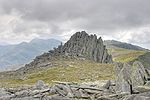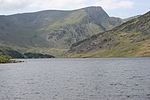Glyder Fach

Glyder Fach is a mountain in Snowdonia, north-west Wales, and is the second highest of the Glyderau and the sixth highest in Wales. Routes to the summit lead from Tryfan and Bristly Ridge to the north, via Glyder Fawr from Pen-y-Pass to the south, and along the Glyder ridge to the east, towards Capel Curig. It is a popular spot for climbers. According to Sir Ifor Williams, the word "Glyder" derives from the Welsh word "Gludair", meaning a heap of stones. Situated near the summit is Y Gwyliwr, a large rock which from the correct angle appears to be precariously balanced, making it a popular place for photographs. (The name means 'The Sentinel', but is usually anglicised as The Cantilever.) Another notable feature, west of the summit, is Castell y Gwynt, a spiky rocky outcrop.
Excerpt from the Wikipedia article Glyder Fach (License: CC BY-SA 3.0, Authors, Images).Glyder Fach
Bristly Ridge,
Geographical coordinates (GPS) Address Nearby Places Show on map
Geographical coordinates (GPS)
| Latitude | Longitude |
|---|---|
| N 53.10491 ° | E -4.00905 ° |
Address
Y Gwyliwr
Bristly Ridge
LL57 3LZ , Capel Curig
Wales, United Kingdom
Open on Google Maps










